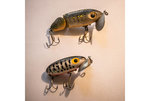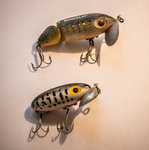 Narrowsburg
NarrowsburgLight Rain Fog/Mist, 43°
Wind: 8.1 mph
 Narrowsburg
NarrowsburgOne of my most successful and reliable lures is the Jitterbug. For anyone who knows the Jitterbug lure, it is a top-water lure made to mimic the sound and appearance of a mouse or small animal that …
Stay informed about your community and support local independent journalism.
Subscribe to The River Reporter today. click here
This item is available in full to subscribers.
Please log in to continue |


 One of my most successful and reliable lures is the Jitterbug. For anyone who knows the Jitterbug lure, it is a top-water lure made to mimic the sound and appearance of a mouse or small animal that has fallen from a tree or the clutches of a bird down to the surface of the water and is now struggling to swim. I first started using this handy little tool when I began accompanying my dad on night fishing trips. Of course, some of the larger predator fish come out to hunt when the sun is down and the water is a sheet of glass. As you sit there, you begin to hear the swish swish sounds of bait as they begin coming to the surface, either feeding themselves or escaping the pushes of the pigs beneath.
One of my most successful and reliable lures is the Jitterbug. For anyone who knows the Jitterbug lure, it is a top-water lure made to mimic the sound and appearance of a mouse or small animal that has fallen from a tree or the clutches of a bird down to the surface of the water and is now struggling to swim. I first started using this handy little tool when I began accompanying my dad on night fishing trips. Of course, some of the larger predator fish come out to hunt when the sun is down and the water is a sheet of glass. As you sit there, you begin to hear the swish swish sounds of bait as they begin coming to the surface, either feeding themselves or escaping the pushes of the pigs beneath.
The Jitterbug makes a noisy entrance to the water since it is a fairly large lure, about the size and weight of a computer mouse. I normally let mine sit for a moment or two before beginning to pull it in. Jitterbugs are buoyant and will remain afloat until they hopefully get crushed. They have a wide spoon like plate across the front that catches air and rocks the lure left and right like a small wriggling animal. As it rocks left and right, the air pocket pops as it meets the surface of the water and does so with whatever speed you reel it in at. I find that the most effective speed is when you can just barely get it to pop. Just fast enough to make that noise, but not so fast that it appears your lure has much energy. Every 10 yards or so stop reeling and give it a long five-count before continuing to reel.
Normally about halfway in, you’re going to see an explosion of water if it’s a bass, or hear a loud suction sound like a ‘clap’ or ‘whack’ if a walleye decides to bring it down. Get that rod tip up and keep the pressure on; now you’re fishing! Jitterbugs require a lot of attention but can be very rewarding. They normally give you a very dynamic battle since you can see everything leading up to actually fighting the fish. They are about 2 to 3 inches long and sport two treble hooks, one in the middle and one off the back. They are great for short-range casts, and night or day fishing. They work well along the front of weeds and aquatic plants; however, they get tangled easily, so keep them out of the vegetation.
They are designed for still water, or at the very least a very subtle ripple. Any kind of large current or chop in the water is going to defeat the purpose of the noise that the nose spoon creates and the lure’s sensory effects will be lost in amidst the activity of the water. Slow, almost still pools on the river would work, but mainly lakes and ponds with no chop from the wind are going to be where you use this lure.
*If you have any luck with the lure of the week, feel free to email your pictures to events@riverreporter.com for an opportunity to share them on our website. If you have a favorite kind of lure we haven’t reviewed yet, feel free to send that lure to our office at PO box 150 Narrowsburg, NY 12764. We will add it to our weekly reviews and share the results. Check back each week on Mondays to see the new lure of the week!
Comments
No comments on this item Please log in to comment by clicking here